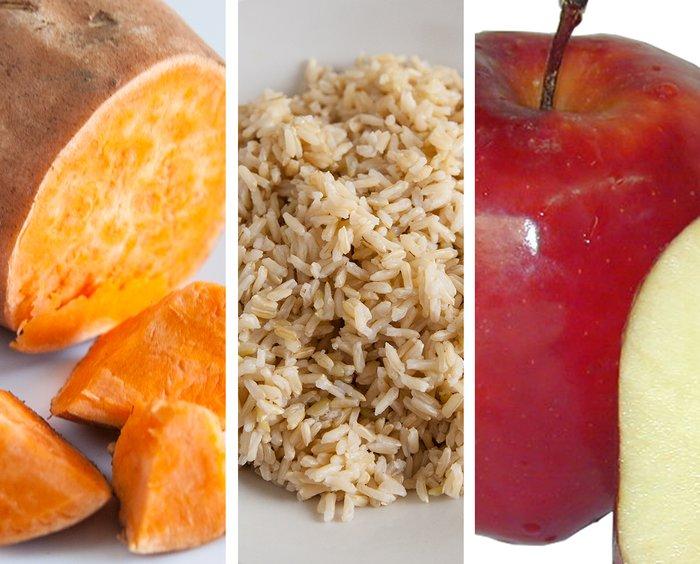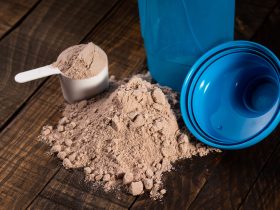Body Builder Nutrition: Facts About Protein, Carbs & Fat
If you want to see the best results from your training program, proper nutrition is critical. This means the proper intake of calories, the proper ratio of macronutrients—protein, carbohydrates, and fats—and the proper timing of these macronutrients.
This also means understanding and maintaining a positive nitrogen balance. Many bodybuilders—beginners and otherwise—do not understand the basics of good nutrition from a bodybuilding standpoint.
The nutrients in food are broken down into the three types of macro-nutrients mentioned above. Macro-nutrients mean nutrients we need in large amounts. Micro-nutrients are vitamins and minerals—micro meaning we need these in small amounts. Each type of nutrient performs specific functions in the body but interacts with other nutrients to carry out those functions.
Protein
The word protein was coined by the Dutch chemist Geradus Mulder in 1838 and comes from the Greek word “photos” which means “of prime importance.” Your body, after water, is largely made up of protein. Protein is used by the body to build, repair and maintain muscle tissue.
The protein consists of amino acids usually referred to as the “building blocks of protein.” There are approximately 20 amino acids, nine of which are considered essential because the body cannot make them, they must be supplied by the diet.
Protein is essential for growth and the building of new tissue as well as the repair of broken down tissue—like what happens when you work out. When you hear the term “positive nitrogen balance,” it refers to being in a state of having enough protein available for the needs of the body and the need of building muscle.
What does nitrogen have to do with protein? Nitrogen is one of the most important elements in all proteins. It is essential to animal life for tissue building.
This statement alone defines the key need for protein when lifting weights. For the most part, we are told to eat sufficient protein (every 3-4 hours) to maintain a positive nitrogen balance because your body is actually in an anabolic, or building up phase in this state, where a negative nitrogen balance, from lack of adequate protein, indicates a catabolic or tearing down state.
This is one reason why protein (and eating enough throughout the day) is important: lack of adequate protein and your body begins to break down tissue (read: muscle) to meet its daily protein needs.
Our bodies constantly assemble, break down and use proteins (in the form of amino acids, which are the building blocks of protein), there are thousands of different protein combinations used by the body, and each one has a specific function determined by its amino acid sequence.
Virtually all modern authorities agree that one to 1 ½ grams of protein per lb. of body weight is best for muscle growth. Besides taking in high-quality protein from food (lean beef, chicken, turkey, fish, eggs), the best way to keep your protein intake at the proper levels is through the use of protein shakes.
The other part of getting the most out of your protein intake and thereby maintaining a positive nitrogen balance is carb and fat intake; both are needed in reasonable amounts to ensure protein synthesis.
As far as powders are concerned, whey protein is the best quality, meaning your body will absorb and use more of it. Whey protein remains number one, because of its high quality, but milk-based proteins are making a comeback, largely because of their long-lasting effects on the body: whey is typically touted as a fast-digesting protein, milk as a slow-digesting protein.
People always judge a protein powder by the number of advertised grams per serving: “This one only has 17 grams, it’s not as good as this one that has 50 grams!”
Wrong, wrong, wrong. The protein contains four calories per gram, that’s how it’s measured, meaning that it doesn’t matter what the label says, they are using different scoop sizes and the number of scoops per serving to get that advertised amount.
Since protein is four calories per gram, and scoop sizes are measured in grams, if you used a standard scoop size and quantity, you would get the same amount of protein, regardless of the brand name (except minor variances for fat and carb content).
Test this out yourself, the next time you’re at the vitamin store, and compare protein labels. Note the protein, carb, and fat per serving. Now note the scoop size and how many scoops equal one serving. You will see that any label with a high advertised protein content is using a large scoop and probably two scoops a serving. A smaller scoop and a serving amount correspond to a protein with a lower advertised amount.
Now let’s get back to my main topic regarding protein. The timing of protein is the key to maintaining a positive nitrogen balance and staying in an anabolic state. You should take in protein every 3-4 hours; your protein intake should be evenly divided up throughout the day over the course of 5-6 meals. This can be three main meals and 2-3 high-protein snacks or shakes.
Other than that, there are some critical times to take in protein—first thing in the morning, with some simple carbohydrates because you have not eaten since the evening before and your body is in a catabolic state.
You should also be sure to take in a protein shake with fast carbohydrates—like fruit—about 1 hour before you train and you should take in a similar shake after you train—this should be, by the way, 40-60 grams of protein and about the same in carbohydrates. Finally, you should have a small protein shake or meal before bed, because during the night you typically fall into a catabolic state.
Good Food Choices For Protein
- Lean beef
- Chicken
- Turkey
- Fish
- Low-fat dairy
Carbohydrates
Carbohydrates have gotten quite a bad rap lately with all this low-carb stuff out there. Are they responsible for fat gain? Should bodybuilders avoid them? The answer is no to both. Carbohydrates are currently viewed as the main culprit for gaining body fat.
Ignored is the fact that carbohydrates are the preferred fuel source for your body’s—and brain’s —energy needs. It’s carb energy that fuels your workouts. There are two key components to carbohydrates that people need to understand: there are two types of carbohydrates, sugary or simple carbohydrates, and complex, slower-burning carbohydrates.
The other thing people need to understand about carbohydrates is that too many calories, of any type, can lead to fat gain. With carbohydrates, people eat too many sugary carb foods, which also contain fat. And while it’s true that you need carbohydrates for energy, you only need so much.
If you overload your energy needs and are not active enough to burn the excess calories, they will be stored as fat. Most people are not that active and they also eat too many calories of all types, this is why obesity is the problem it is today.
Most people do not understand what a calorie is. The production of energy is measured in calories. The calorie content of a food is determined by measuring the amount of heat produced by that food in a laboratory device called a calorimeter.
Somewhere along the way, food became a matter of taste—the higher the fat and sugar content the better. The basic function of food was forgotten. As a bodybuilder, you should be concerned about your calorie needs and types, and also you should have at least an idea, and at best be keeping a diet log, of what you eat every day—in terms of types of calories and total calories.
When trying to gain mass, you need around 2-3 grams per lb. of body weight of preferably complex carbohydrates. If you have a high percentage of body fat, drop that amount to 1 ½ grams per lb. of body weight. The only real times to take in simple carbohydrates are with the pre/post workout and morning shakes mentioned above.
As well, as a bodybuilder, you should have a far better understanding of carbohydrates than the average person. As I said before, carbohydrates are the body’s preferred energy source. Once ingested, they are turned into glucose, which, among other things, fuels muscular contractions, and glycogen, which is stored in the muscles and liver for future use.
Without enough stored carbohydrates in the muscles, they take on a flat appearance and you lack the energy to train hard. As long as your carb intake doesn’t overwhelm your energy needs, you do not have to worry about fat gains from carb intake.
Good Food Choices For Carbohydrates Are
- Whole grains
- Oatmeal
- Brown rice
- Sweet potatoes
Simple Carbohydrates
- Fruit juice
- All sugars
Good Fruit Choices Include
- Bananas
- Pears
- Apples
- Oranges
Fats
Fats, technically called lipids, are the most energy dense of the three macronutrients. They are composed of building blocks called fatty acids, which fall into three main categories:
1. Saturated
Found mainly in animal and dairy products, such as whole milk, cheese, beef, veal, lamb, pork and ham. Also, you will find this type of fat in some oils, such as coconut, palm kernel, and vegetable shortening. Saturated fat is used by the liver to make cholesterol, which is involved in the production of hormones such as testosterone. This is important—you need some fat in your diet to keep your body’s hormone production where it should be.
2. Polyunsaturated
Found in things like corn, soybeans, safflower, and sunflower oils. Some fish oils are also high in polyunsaturated fats. This type of fat may help lower total cholesterol. Since this includes good cholesterol, the intake of this type of fat should be limited.
3. Monounsaturated
Found in vegetable and nut oils, such as olive, peanut, and canola. They can help lower LDL, or bad cholesterol without lowering HDL, or good cholesterol.
Most foods are a combination of all 3 fatty acid types, one is typically the dominant type which therefore dictates its classification.
Trans Fats
These occur when polyunsaturated oils are altered through hydrogenation, a process used to harden liquid vegetable oils into solid foods like margarine and shortening.
Fat intake should be kept low. In fact, many bodybuilders find that fat is naturally kept at low levels by simply eating “clean”—lean meat and dairy sources of protein and complex carbohydrates as listed below. Some bodybuilders add an omega-3 fatty acid supplement to their diet to ensure a source of healthy fats.
Food Choices For Fats Are
- Flaxseed
- Sunflower seeds
- Canola oil
- Olive oil
Fats To Avoid
- Processed vegetable oils
Fats To Limit
- Butter
- Saturated Fats
Diet Journal
It makes a lot of sense to keep a journal of how much protein, carb, and fat grams you eat every day, the time ate, and your total calorie intake. If you’re serious about building muscle, why guess at the number of calories and grams of protein, etc.? You don’t make gains by guessing. You can add your supplement schedule to this as well.




